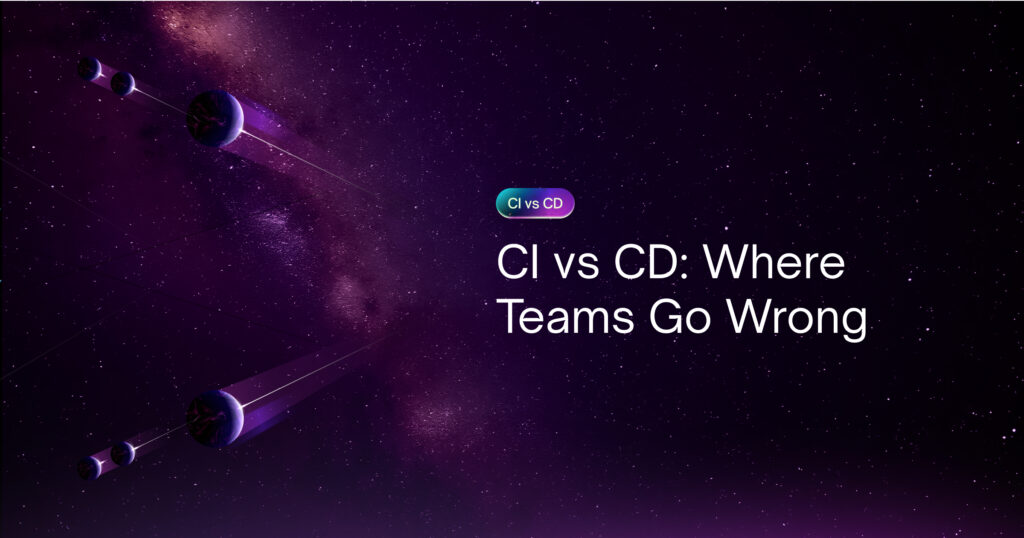
CI/CD is often spoken of as a unified concept, yet conflating Continuous Integration (CI) with Continuous Delivery (CD) is a frequent and costly mistake. When fast-scaling engineering teams treat these distinct practices as interchangeable, they introduce hidden inefficiencies that slow down software delivery and burden DevOps workflows.
This article clarifies the strategic and operational differences between CI and CD, explores common pitfalls, and outlines how engineering leaders can foster a more mature delivery pipeline.
Why CI and CD Are Not the Same Many Teams Treat Them That Way
- CI (Continuous Integration) focuses on merging code changes frequently and validating them through automated tests.
- CD (Continuous Delivery) ensures that integrated code can be deployed reliably to production or staging environments.
Conflating these practices leads to:
- A false sense of readiness based on passing test suites.
- Partial automation where manual QA and approvals remain bottlenecks.
- Tooling that supports CI but lacks the orchestration required for CD.
The outcome: an integration pipeline that moves quickly but cannot deliver value to users efficiently.
CI Done Right: Fast, Isolated, and Predictive
Continuous Integration (CI) is the bedrock of modern software development, designed to catch issues early and enable faster, safer code merges. But to deliver these benefits, CI needs to be fast, trustworthy, and easy to maintain.
When done right, CI should confidently answer: Is this code safe to integrate? That requires more than just plugging in a testing tool, it demands intentional workflows and reliable feedback loops.
Best practices include:
- Rapid feedback loops with test execution on every commit.
- Isolated test environments to ensure consistency.
- Pre-merge checks within pull requests.
- Static analysis, linting, and type safety enforcement.
- Clear, team-wide visibility into build status.
However, many teams fall short due to:
- Slow pipelines that hinder developer velocity.
- Flaky tests that reduce trust in results.
- Unclear accountability for maintaining test health.
CD Done Right: Reliable, Observable, and Reversible
While Continuous Integration focuses on ensuring code changes are safe to merge, Continuous Delivery (CD) addresses the challenge of getting that code into the hands of users safely and reliably. This step is where many teams stumble. CD is not just about automation—it’s about trust, traceability, and the ability to move quickly without compromising system stability.
Continuous Delivery aims to answer: Can this code be deployed safely to end users?
Mature CD practices include:
- Automated deployment pipelines to multiple environments.
- Rollback mechanisms and deployment versioning.
- Integrated observability to monitor deployment impact.
- Incremental rollout strategies, such as canaries and feature flags.
- Enforced policies for security and compliance.
Common pitfalls:
- Manual deployment steps that rely on tribal knowledge.
- Insufficient monitoring linked to deploy events.
- Inability to revert quickly in case of failure.
- Inconsistent environments across testing and production.
Bridging the Gap: Organizational and Technical Barriers
The disconnect between Continuous Integration and Continuous Delivery often stems not from technical limitations alone but from deeper organizational and process-level gaps. These barriers, while subtle, create misalignments that prevent a smooth and reliable software delivery pipeline.
Several contributing factors include:
- Siloed responsibilities: In many organizations, development teams focus solely on CI, building and testing code, while operations or DevOps teams are left to manage the complexities of CD. This division leads to unclear ownership and fragmented accountability.
- Fragmented tooling: CI and CD are often managed using disparate systems. For example, teams might use Jenkins or GitHub Actions for CI while relying on ad hoc scripts, Terraform modules, or third-party orchestrators for deployment. This patchwork approach increases integration overhead and brittleness.
- Delayed compliance integration: Security and compliance checks are frequently bolted on late in the process, often after the code is already on its way to production. This delay creates tension between speed and governance and exposes teams to avoidable risks.
- Lack of standard workflows: Without reusable patterns and golden paths for common deployment scenarios, teams resort to one-off processes that are prone to error, difficult to audit, and hard to scale across multiple services or environments.
Addressing these issues requires not only better tooling but also cultural and process shifts that emphasize shared ownership, automated governance, and platform-centric thinking.
How Revolte Unifies CI and CD
Revolte addresses the CI/CD divide by offering a cohesive, Git-native platform that streamlines the software delivery lifecycle. Designed with platform engineering in mind, Revolte simplifies complex DevOps workflows, enhances CI/CD pipeline reliability, and enables fast, secure deployments without toolchain sprawl. Whether you’re aiming for scalable software delivery or compliance-first automation, Revolte provides the control and visibility your teams need.
- Unified Pipelines: One agentic workflow automates building, testing, deploying, and rollback from a single Git trigger.
- Integrated Policy Enforcement: Security, compliance, and access controls are embedded directly into pipelines.
- Observability by Default: Developers and platform teams have real-time visibility into build and deploy status.
- Intelligent Recovery: Automated rollback ensures resilience without requiring manual intervention.
- Developer-Centric UX: Declarative configurations and prebuilt templates reduce cognitive load and prevent misconfiguration.
Deliver with Confidence, Not Just Speed
Continuous Integration and Continuous Delivery serve different but complementary purposes. Engineering teams that recognize and respect these distinctions gain a competitive advantage through faster, safer, and more reliable software delivery.
Revolte helps teams close the CI/CD gap, enabling a seamless, intelligent pipeline from commit to customer.
→ Explore how Revolte can transform your delivery workflows: Try Revolte